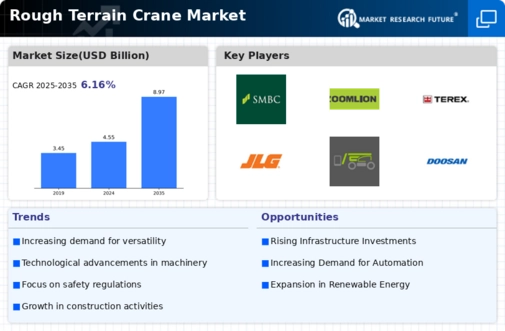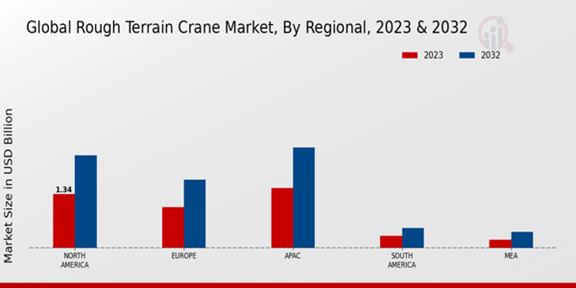Infrastructure Development
The Global Rough Terrain Crane Market Industry is experiencing a surge in demand due to extensive infrastructure development projects worldwide. Governments are investing heavily in transportation, energy, and urban development, which necessitates the use of specialized cranes. For instance, the construction of new highways and bridges requires cranes that can operate on uneven terrain. This trend is expected to contribute to the market's growth, with projections indicating a market value of 4.55 USD Billion in 2024, potentially reaching 8.97 USD Billion by 2035, reflecting a compound annual growth rate (CAGR) of 6.36% from 2025 to 2035.
Technological Advancements
Technological innovations in crane design and functionality are driving the Global Rough Terrain Crane Market Industry forward. Manufacturers are increasingly integrating advanced features such as telematics, automated controls, and enhanced safety systems. These advancements not only improve operational efficiency but also enhance safety standards on construction sites. For example, cranes equipped with real-time monitoring systems can provide critical data to operators, reducing the risk of accidents. As these technologies become more prevalent, they are likely to attract new investments and expand the market's reach, aligning with the projected growth trajectory.
Rising Demand in Emerging Economies
Emerging economies are witnessing rapid urbanization and industrialization, which is significantly impacting the Global Rough Terrain Crane Market Industry. Countries in Asia-Pacific and Latin America are investing in infrastructure projects, leading to an increased demand for rough terrain cranes. For instance, the construction of new residential complexes and commercial buildings in these regions requires cranes capable of navigating challenging landscapes. This trend is expected to bolster market growth, as these economies are projected to contribute substantially to the overall market value, aligning with the anticipated increase to 8.97 USD Billion by 2035.
Increased Focus on Safety Regulations
The Global Rough Terrain Crane Market Industry is also influenced by the growing emphasis on safety regulations in construction and industrial sectors. Stricter safety standards necessitate the use of advanced cranes that comply with regulatory requirements. As companies strive to minimize workplace accidents, the demand for cranes equipped with enhanced safety features is likely to rise. This shift not only promotes safer working environments but also drives the adoption of rough terrain cranes, contributing to the market's growth. The alignment of safety regulations with technological advancements may further enhance the industry's appeal.
Environmental Sustainability Initiatives
The Global Rough Terrain Crane Market Industry is increasingly shaped by environmental sustainability initiatives. As companies and governments prioritize eco-friendly practices, there is a growing demand for cranes that are energy-efficient and produce lower emissions. Manufacturers are responding by developing cranes that utilize alternative fuels and incorporate sustainable materials. This shift towards greener technologies is likely to attract environmentally conscious clients and projects, thereby expanding the market. The integration of sustainability into crane operations not only aligns with global environmental goals but also positions the industry for future growth.


























Leave a Comment